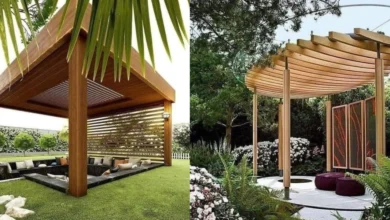Home garden design :with the best tips for choosing the right plants for your climate
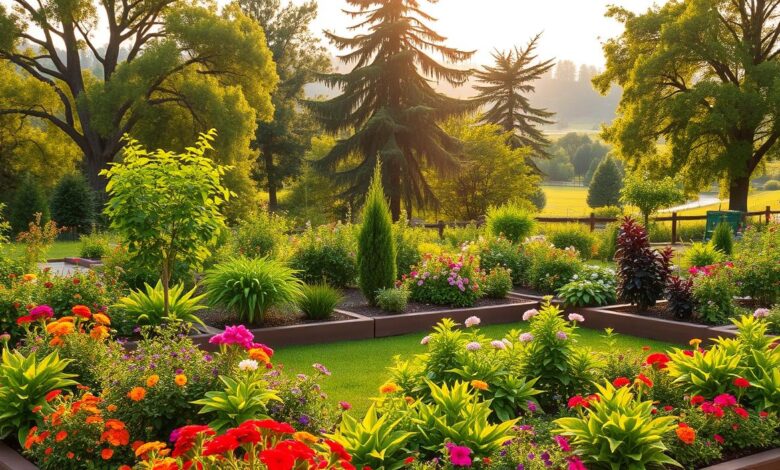
Home garden design begins with choosing plants that are suitable for your climate. A well-designed garden enhances your home’s appearance, provides a peaceful space, and even increases your property’s value. Focus on designing and planning your home garden to choose plants that grow well in your area.
In home garden design, mixing beauty and function is important. By picking the right plants, you can make an outdoor space that shows your style and meets your needs. Good planning means thinking about your climate and picking plants that fit it well.
Table of Contents
Key Considerations
Starting your home garden design journey? Remember, picking the right plants is key to a beautiful and useful outdoor space. By focusing on home garden planning and choosing plants that do well in your area, you can make a stunning garden. This garden will improve your quality.
Key Takeaways
- Choose plants that thrive in your local climate to ensure a beautiful and functional home garden.
- Effective home garden planning involves considering the specific conditions of your climate.
- Integrating aesthetics and practicality is key to successful home garden design.
- Selecting the right plants can enhance the aesthetic appeal of your home and increase your property value.
- Home garden design and home garden planning are crucial to creating a stunning outdoor space.
- By choosing the right plants, you can create a peaceful retreat that reflects your personal style and meets your needs.
Understanding the Fundamentals of Home Garden Design
Creating a beautiful outdoor space is all about aesthetic garden design. A well-designed garden can make your property look and feel better. It becomes the perfect place for relaxation and fun. To make it great, think about what everyone in your family needs and plan different areas for different activities.
In modern home gardens, it’s important to mix looks with function. Your garden should be both beautiful and useful for your family. You can make spaces for relaxing, playing, or eating outside. This way, you create a space that’s enjoyable for everyone.
- Define different areas for relaxation, entertainment, and recreation
- Consider the needs of all family members
- Balance form and function to create a harmonious and functional outdoor space
By following these tips, you can make a beautiful and useful outdoor space. It will improve your life and make your home better.
Climate Considerations in Garden Planning
When designing your home garden, choosing the right plants is key. Your region’s climate greatly affects which plants will do well and need little care. By picking plants that fit your local climate, you can make a sustainable garden. This garden will be stunning and also good for the planet.
To make a garden that can handle the climate, think about your area’s temperature and rain. This helps you pick plants that don’t need much water or care. Some good choices include:
- Native plants that are made for your local weather
- Drought-tolerant plants that need little water
- Heat-resistant plants that do well in hot weather
Adding these plants to your garden makes it both lovely and eco-friendly. Always think about your area’s climate when choosing the right plants for your garden.
Essential Elements of Modern Garden Layouts
Designing a modern home garden is all about finding the right mix. It should look great and work well, too. A good garden is both beautiful and practical, fitting your lifestyle perfectly.
Modern gardens often have different areas for sitting, playing, and growing plants. These spots make the garden more fun and useful. Paths and transitions are also key, helping people move around easily.
Here are some tips for making the most of your garden space:
- Start by checking out your garden and seeing what needs work
- Try using space-saving ideas like vertical gardens
- Choose items that serve more than one purpose, like seats that also store things
By focusing on these key points, you can make a garden that’s both stunning and useful. Whether you want a quiet spot or a place for parties, a well-designed garden can make your outdoor time better. It can even make your home more valuable. With the right design and landscaping, you can create the perfect outdoor space.
Selecting Climate-Appropriate Plants for Your Region
When picking plants for your garden, knowing your region’s climate is key. This helps your garden grow well and stay easy to care for. Think about the temperature, how much rain you get, and your soil type when choosing plants. This way, your garden will look great and be sustainable.
In home garden design, native plants and succulents are great choices. They fit well with your local climate and need less care. This makes them ideal for sustainable gardens. Plants like cacti, succulents, and drought-tolerant grasses are good examples.
Here are some tips for picking the right plants:
- Research plants that are native to your region
- Consider the temperature and precipitation patterns in your area
- Choose plants that are adapted to your soil type
By using these tips and choosing the right plants for your area, you can make a stunning and sustainable garden. This garden will need less upkeep and care. It will also help the environment and give you a lovely outdoor space.
Incorporating Native Species in Your Garden Design
Creating a beautiful and sustainable home garden design is easier with native species. They attract local wildlife and need less care. Native plants are perfect for your aesthetic garden design because they thrive in local conditions.
Native plants make your garden unique and stunning. They need less water, pruning, and fertilization. This choice is good for the environment and saves you money and effort.
Benefits of Local Plant Species
- Attract local wildlife, such as birds and butterflies
- Reduce maintenance requirements, such as watering and pruning
- Create a unique and beautiful landscape that reflects the local environment
Seasonal Planning with Native Plants
Planning for different seasons is key to a stunning garden. Pick native plants that bloom at various times. This way, your home garden design stays interesting and beautiful all year.
Smart Material Selection for Garden Spaces
Choosing the right materials is key for a great outdoor space. A good home garden design should use materials that last and are good for the planet. Sustainable gardens are essential, and the right materials can help.
For a modern garden, gravel and artificial grass are smart picks. Gravel is great for paths and ground cover because it’s easy to care for and helps with water flow. Artificial grass is a good choice instead of real grass because it uses less water and needs less care.
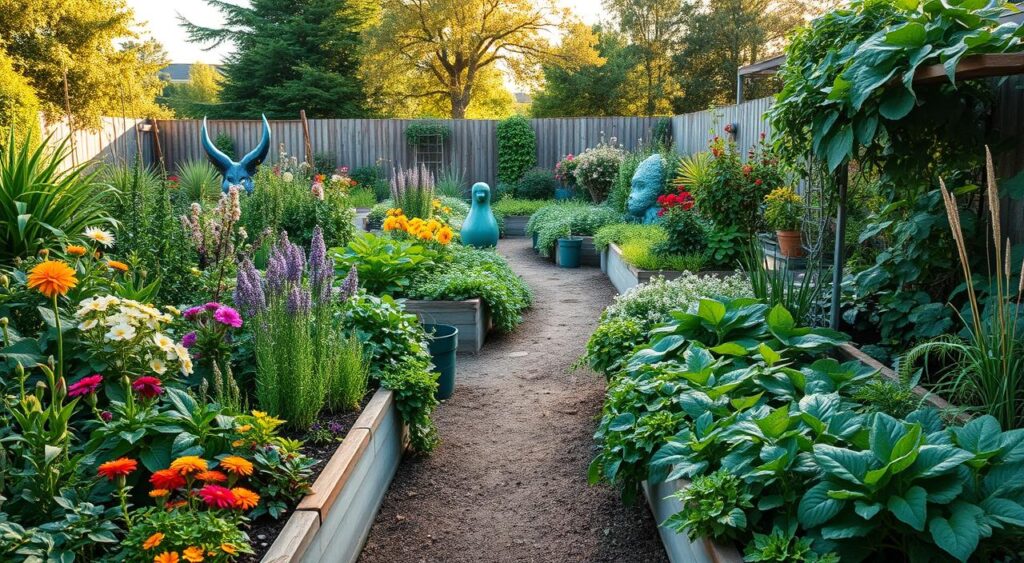
- Low-maintenance requirements
- Durability and long lifespan
- Environmental benefits, such as reduced water consumption and waste
Using these materials in your garden can make it beautiful and easy to keep up. It’s a win-win for your outdoor space.
Integrating Hardscape Elements
Hardscape elements are key in home garden design. They boost both the looks and function of outdoor areas. In modern home gardens, gravel, stone, and artificial turf are favorites. They’re tough and easy to care for.
In home garden landscaping, gravel and stone make great walkways and open spots. Gravel drains water well, preventing erosion and puddles. It also adds texture and interest, making your garden welcoming.
Working with Gravel and Stone
- Gravel and stone can be used to create decorative borders and pathways
- They can help reduce maintenance requirements by suppressing weed growth
- Gravel and stone can also be used to create beautiful patios and outdoor seating areas
Artificial Turf Applications
Artificial turf is a hit in modern home gardens. It makes for easy-care lawns and spaces. It’s ideal for those who want to enjoy their yard without upkeep worries.
Creating Sustainable Garden Environments
When designing your home garden, think about its impact on the environment. Sustainable gardens help the planet, support biodiversity, and cut down on waste. To make your garden eco-friendly, consider a few key tips.
For example, smart irrigation systems can save a lot of water. This makes your garden more sustainable. Simple changes can make a big difference in your garden’s health and the planet’s.
Start by using plants that don’t need much water. Reduce lawn areas and use efficient watering systems. These steps help create a green and beautiful outdoor space. Here are some tips to begin:
- Choose plants native to your region to reduce the need for excessive watering and care
- Implement a rainwater harvesting system to collect and reuse rainwater
- Incorporate compost and organic matter into your soil to improve its structure and fertility
By using these tips, you can make a beautiful and eco-friendly garden. It will not only help the environment but also be a peaceful spot for you and your family. Every small change helps, and sustainable gardens are a great step towards a greener lifestyle.
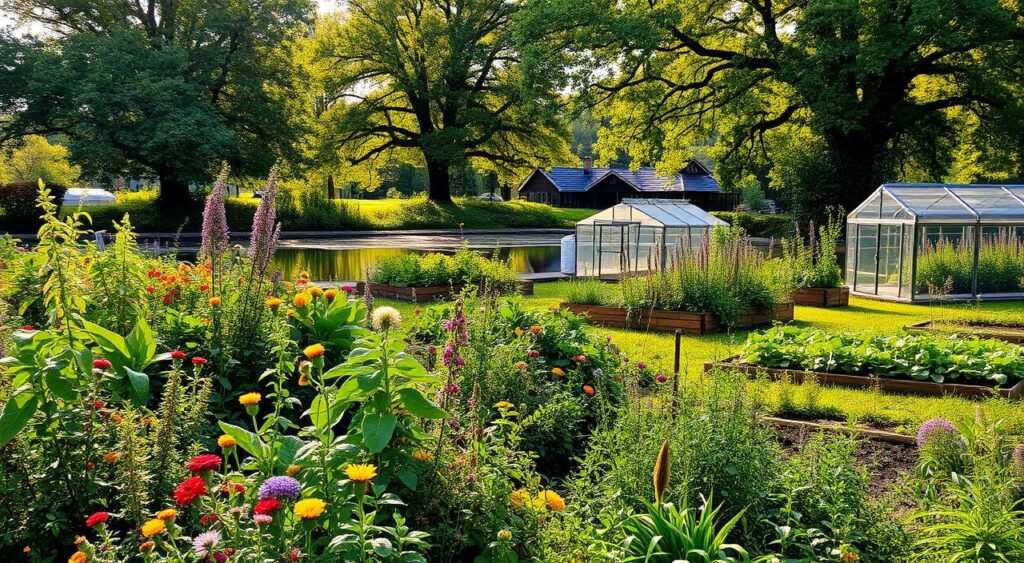
Outdoor Living Space Design
Creating an inviting outdoor space means making it blend well with your home garden. Innovative ideas help turn your outdoor area into a beautiful, functional spot. With the right elements, you can make a space that shows off your style.
Every detail counts in a well-designed garden. Choose furniture that fits your space, thinking about durability, comfort, and style. Adding things like lamps and statues can make your outdoor area cozy and perfect for relaxing or having fun.
To make your outdoor space even better, add lighting that shows off your garden. Use string lights, lanterns, or spotlights to highlight your garden’s best features. This way, you create a beautiful, functional space that’s great for living and entertaining outdoors.
Some important things to think about when designing your outdoor space include:
- Choosing plants and materials that work well in your climate
- Adding decorative features like water features or fire pits
- Placing furniture and lights to make a welcoming atmosphere
By focusing on these points, you can make an outdoor space that’s not just a part of your garden but also a place where you and your family can have fun.
Water-Wise Garden Planning
When designing your home garden, think about saving water. A water-wise garden cuts down on water use and supports the planet. Using smart irrigation and drought-resistant plants is key.
In a well-designed garden, every part works together. Choosing tips that save water lets you have a green garden without harming the environment. Rainwater harvesting and efficient watering are good ways to start.
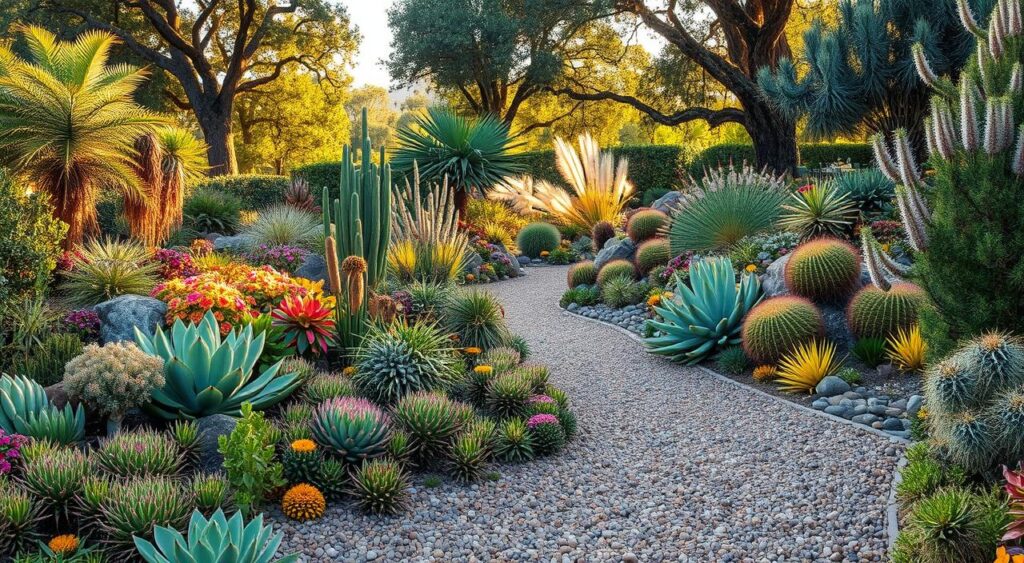
- Install a smart irrigation system that adjusts watering based on weather
- Choose plants that need little water
- Use mulch and compost to keep soil moist and cut down on evaporation
By using these water-saving methods, you can make a beautiful and eco-friendly garden. It’s good for you and the planet.
Year-Round Garden Maintenance Strategies
Starting your home garden design journey means thinking about maintenance all year. A well-kept garden looks great and supports plant health. Begin with a schedule for planting, pruning, and watering.
In home garden landscaping, know what your plants need. Some need more water, others need regular pruning. This way, you can tailor care to keep your garden lively all year.
Here are some garden design tips to remember:
- Plant a mix of flowers and plants that bloom at different times for color all year.
- Use evergreen and deciduous plants for texture and depth in your garden.
- Think about adding a water feature, like a pond or fountain, for interest.
Follow these tips and make a maintenance plan. This way, you’ll have a beautiful garden all year. Be ready to change your plan as your garden grows and changes.
Conclusion: Creating Your Perfect Climate-Adapted Garden
Starting your home garden design journey is exciting. It’s about finding the right mix of beauty and function. By planning well and picking the best plants for your climate, you can create a beautiful and useful outdoor space. It will show off your style and make your home better.
In this guide, we covered key steps for home garden planning. We talked about knowing your local climate and picking the right plants and materials. Using these tips, you can make a home garden that’s not just pretty but also does well in your area.
Remember, your home garden design is a work in progress. It needs care and flexibility to stay great. By watching your garden’s needs and making changes when needed, it will keep thriving. This way, you’ll enjoy your garden for years to come.


